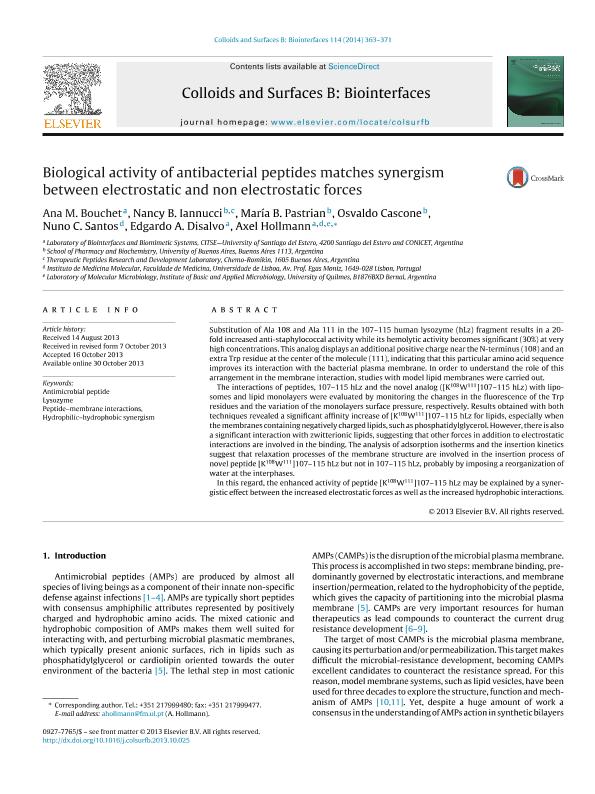Mostrar el registro sencillo del ítem
dc.contributor.author
Bouchet, Ana María

dc.contributor.author
Iannucci, Nancy Beatriz

dc.contributor.author
Pastrian, María Belén

dc.contributor.author
Cascone, Osvaldo

dc.contributor.author
Santos, Nuno C.
dc.contributor.author
Disalvo, Edgardo Anibal

dc.contributor.author
Hollmann, Axel

dc.date.available
2020-05-15T20:16:49Z
dc.date.issued
2014-07
dc.identifier.citation
Bouchet, Ana María; Iannucci, Nancy Beatriz; Pastrian, María Belén; Cascone, Osvaldo; Santos, Nuno C.; et al.; Biological activity of antibacterial peptides matches synergism between electrostatic and non electrostatic forces; Elsevier Science; Colloids and Surfaces B: Biointerfaces; 114; 7-2014; 363-371
dc.identifier.issn
0927-7765
dc.identifier.uri
http://hdl.handle.net/11336/105284
dc.description.abstract
Substitution of Ala 108 and Ala 111 in the 107–115 human lysozyme (hLz) fragment results in a 20- fold increased anti-staphylococcal activity while its hemolytic activity becomes significant (30%) at very high concentrations. This analog displays an additional positive charge near the N-terminus (108) and an extra Trp residue at the center of the molecule (111), indicating that this particular amino acid sequence improves its interaction with the bacterial plasma membrane. In order to understand the role of this arrangement in the membrane interaction, studies with model lipid membranes were carried out. The interactions of peptides, 107–115 hLz and the novel analog ([K108W111]107–115 hLz) with liposomes and lipid monolayers were evaluated by monitoring the changes in the fluorescence of the Trp residues and the variation of the monolayers surface pressure, respectively. Results obtained with both techniques revealed a significant affinity increase of [K108W111]107–115 hLz for lipids, especially when the membranes containing negatively charged lipids, such as phosphatidylglycerol. However,there is also a significant interaction with zwitterionic lipids, suggesting that other forces in addition to electrostatic interactions are involved in the binding. The analysis of adsorption isotherms and the insertion kinetics suggest that relaxation processes of the membrane structure are involved in the insertion process of novel peptide [K108W111]107–115 hLz but not in 107–115 hLz, probably by imposing a reorganization of water at the interphases. In this regard, the enhanced activity of peptide [K108W111]107–115 hLz may be explained by a synergistic effect between the increased electrostatic forces as well as the increased hydrophobic interactions.
dc.format
application/pdf
dc.language.iso
eng
dc.publisher
Elsevier Science

dc.rights
info:eu-repo/semantics/openAccess
dc.rights.uri
https://creativecommons.org/licenses/by-nc-sa/2.5/ar/
dc.subject
ANTIMICROBIAL PEPTIDE
dc.subject
LYSOZYME
dc.subject
PEPTIDEMEMBRANE INTERACTION
dc.subject
HYDROPHILIC HYDROPHOBIC SYNERGISM
dc.subject.classification
Biotecnología relacionada con la Salud

dc.subject.classification
Biotecnología de la Salud

dc.subject.classification
CIENCIAS MÉDICAS Y DE LA SALUD

dc.title
Biological activity of antibacterial peptides matches synergism between electrostatic and non electrostatic forces
dc.type
info:eu-repo/semantics/article
dc.type
info:ar-repo/semantics/artículo
dc.type
info:eu-repo/semantics/publishedVersion
dc.date.updated
2020-04-28T14:07:38Z
dc.journal.volume
114
dc.journal.pagination
363-371
dc.journal.pais
Países Bajos

dc.journal.ciudad
Amsterdam
dc.description.fil
Fil: Bouchet, Ana María. Consejo Nacional de Investigaciones Científicas y Técnicas. Centro de Investigaciones y Transferencia de Santiago del Estero. Universidad Nacional de Santiago del Estero. Centro de Investigaciones y Transferencia de Santiago del Estero; Argentina
dc.description.fil
Fil: Iannucci, Nancy Beatriz. Romikin S.a; Argentina. Universidad de Buenos Aires. Facultad de Farmacia y Bioquímica. Departamento de Microbiología, Inmunología y Biotecnología. Cátedra de Microbiología Industrial y Biotecnología; Argentina
dc.description.fil
Fil: Pastrian, María Belén. Universidad de Buenos Aires. Facultad de Farmacia y Bioquímica. Departamento de Microbiología, Inmunología y Biotecnología. Cátedra de Microbiología Industrial y Biotecnología; Argentina
dc.description.fil
Fil: Cascone, Osvaldo. Universidad de Buenos Aires. Facultad de Farmacia y Bioquímica. Departamento de Microbiología, Inmunología y Biotecnología. Cátedra de Microbiología Industrial y Biotecnología; Argentina. Consejo Nacional de Investigaciones Científicas y Técnicas; Argentina
dc.description.fil
Fil: Santos, Nuno C.. Universidade Nova de Lisboa. Faculdade de Ciencias Medicas.; Portugal
dc.description.fil
Fil: Disalvo, Edgardo Anibal. Consejo Nacional de Investigaciones Científicas y Técnicas. Centro de Investigaciones y Transferencia de Santiago del Estero. Universidad Nacional de Santiago del Estero. Centro de Investigaciones y Transferencia de Santiago del Estero; Argentina
dc.description.fil
Fil: Hollmann, Axel. Universidad Nacional de Quilmes. Departamento de Ciencia y Tecnologia. Instituto de Microbiologia Basica y Aplicada.; Argentina. Consejo Nacional de Investigaciones Científicas y Técnicas. Centro de Investigaciones y Transferencia de Santiago del Estero. Universidad Nacional de Santiago del Estero. Centro de Investigaciones y Transferencia de Santiago del Estero; Argentina. Universidade Nova de Lisboa. Faculdade de Ciencias Medicas.; Portugal
dc.journal.title
Colloids and Surfaces B: Biointerfaces

dc.relation.alternativeid
info:eu-repo/semantics/altIdentifier/url/http://authors.elsevier.com/sd/article/S0927776513006656.
dc.relation.alternativeid
info:eu-repo/semantics/altIdentifier/doi/http://dx.doi.org/10.1016/j.colsurfb.2013.10.025
Archivos asociados
